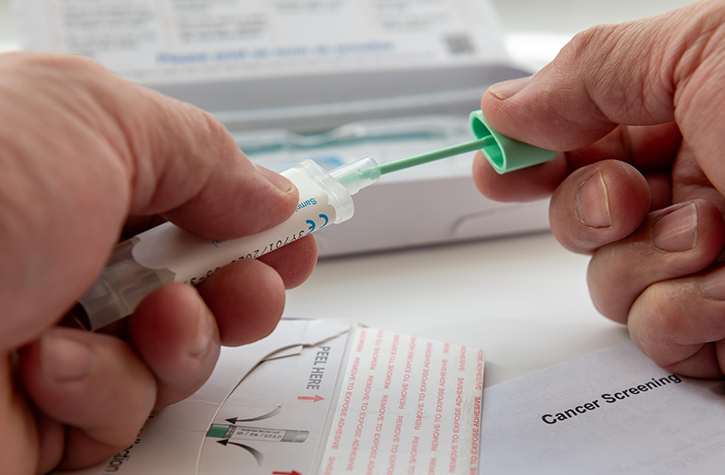May 31, 2023
Most patients with aortic stenosis — a common and potentially life-threating heart valve problem — have time to plan and prepare for a transcatheter aortic valve replacement (TAVR). But there are a small number of hospitalized patients who urgently need the procedure because their heart is in acute distress. New research from Kaiser Permanente Northern California shows that outcomes for these patients may not be as good as they are for patients who have a scheduled procedure.
 The study, published in Structural Heart, included 1,564 adults who had a TAVR for aortic stenosis between 2013 and 2019 at Kaiser Permanente Northern California. The researchers found that the 81 (5%) of patients who had an emergency TAVR were nearly twice as likely to die within a year of their procedure than the 1,483 (95%) of patients who had a scheduled procedure. They were also nearly twice as likely to not see any improvement in their quality of life within a year of their procedure and more likely to need to be readmitted to the hospital. These findings support previous studies evaluating TAVR outcomes based on procedure timing.
The study, published in Structural Heart, included 1,564 adults who had a TAVR for aortic stenosis between 2013 and 2019 at Kaiser Permanente Northern California. The researchers found that the 81 (5%) of patients who had an emergency TAVR were nearly twice as likely to die within a year of their procedure than the 1,483 (95%) of patients who had a scheduled procedure. They were also nearly twice as likely to not see any improvement in their quality of life within a year of their procedure and more likely to need to be readmitted to the hospital. These findings support previous studies evaluating TAVR outcomes based on procedure timing.
“We know that when things happen in a planned fashion that we have time to do everything and control all the parameters that are controllable,” said senior author Jacob M. Mishell, MD, an interventional cardiologist with The Permanente Medical Group who helped build Kaiser Permanente’s TAVR program. “But when a person is hospitalized and needs a TAVR right away, that latitude is taken away. By learning more about the patients who need emergency procedures, we can help improve patient care.”
Aortic valve stenosis occurs when the valve of the aorta — the main artery that carries blood away from the heart — becomes stiff and can’t fully open. This can affect organs throughout the body. It can also lead to heart failure. For decades, open heart surgery was the only treatment for aortic valve stenosis.

Justin Slade, MD
Most patients with an aortic valve stenosis will be treated with a TAVR, a procedure that began to be used in 2011. During the minimally invasive procedure, an interventional cardiologist inserts a thin tube into a blood vessel in the groin or chest, guides it to the heart, and then uses miniature tools that fit inside the tube to put in a new valve. The procedure takes significantly less time than open heart surgery, and recovery is much faster.
The study found that the patients who needed an emergency TAVR went into the procedure with more heart-related health problems. “The patients who needed emergency surgery were similar to the other group in terms of their rates of diabetes and chronic kidney, lung, and liver disease,” said first author Justin J. Slade, MD, a delivery science fellow at the Kaiser Permanente Division of Research and a cardiology fellow at the Kaiser Permanente San Francisco Medical Center. “But they had higher rates of heart-related health problems, like heart failure and coronary artery disease or to previously have had a balloon valvuloplasty, to open a narrowed valve. And because of this, they were more likely to be in the position where they were hospitalized and in need of an emergency procedure.”
The research underscores how important routine surveillance is for patients with aortic disease. “Patients with moderate aortic disease who do not need a valve replacement may think they are doing OK and not come in for an echocardiogram that would allow us to plan for the TAVR,” said Dr. Mishell. “Instead, these patients learn that they need a TAVR after they are already admitted to the hospital.”

Andrew Ambrosy, MD
The findings will also help cardiologists manage patients’ expectations on how their health will change after the procedure. “I’ll definitely use the findings from this study to explain the risks and benefits from the procedure differently to patients who I’m seeing in the clinic compared to those I’m seeing in the hospital,” said co-author Andrew Ambrosy, MD, a research scientist at the Division of Research and a TPMG cardiologist. “If they need a TAVR, it’s still medically the right thing to do. But we have to acknowledge that there are some greater risks for those already hospitalized.”
The new study represents just one of a large number of studies in KP Northern California’s research portfolio designed to help doctors nationwide identify who would benefit most from a TAVR procedure, and when. For example, KP Northern California is currently enrolling patients with moderate aortic disease in a national study comparing TAVR to close follow-up. The trial is designed to determine whether early intervention is beneficial.
Another clinical trial that has completed enrollment is investigating whether there are benefits to treating severe aortic stenosis if it isn’t causing any apparent symptoms. Findings from this study will be published after the trial has followed the patients for at least 2 years.

Alan Go, MD
“We are proud to be able to conduct both clinical trials and the observational research studies that our integrated health care delivery framework and state-of-the-art electronic health record system makes possible,” says Alan S. Go, MD, a research scientist at the Division of Research and regional medical director for KP Norther California’s Clinical Trials Program. “What we are learning from both types of studies will improve care not only for our members, but for anyone diagnosed with aortic valve stenosis who may require intervention.”
The study was funded by The Permanente Medical Group’s Delivery Science and Applied Research program and the Kaiser Permanente Northern California Community Health Research Grants Program.
Co-authors include Thomas K. Leong, MPH; Sue Hee Sung, MPH; and Elisha A. Garcia, BS, of the Division of Research; and Ivy A. Ku, MD, MAS; Matthew D. Solomon MD, PhD; Edward J. McNulty, MD; Andrew N. Rassi, MD; David C. Lange, MD; and Femi Philip, MD, of The Permanente Medical Group.
This article originally appeared in Division of Research Spotlight.






